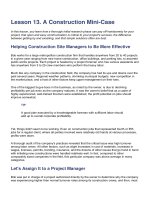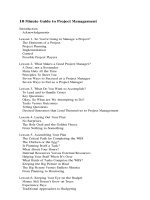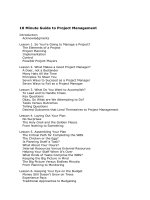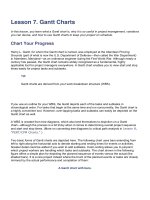management alpha 10 Minute Guide to Project Management PHẦN 3 pps
Bạn đang xem bản rút gọn của tài liệu. Xem và tải ngay bản đầy đủ của tài liệu tại đây (47.64 KB, 13 trang )
● Do I understand the project's justification? Why does someone consider this project to be
important? If you are in a large organization, this means contemplating why the authorizing
party initiated the assignment and whom he or she had to sell before you were brought into
the picture.
● Do I understand the project's background? It is unlikely that the project exists in a vacuum.
Probe to find out what has been done in this area previously, if anything. If the project
represents a new method or procedure, what is it replacing? Is the project a high priority
item within your organization, or is it something that is not necessarily crucial to continuing
operations?
● Do I understand the project's politics? Who stands to benefit from the success of the full
completion of this project? Whose feathers may be ruffled by achieving the desired
outcome? Who will be supportive? Who will be resistant?
● Do I understand who the players are and the role they will take? Who can and will
contribute their effort and expertise to the project? Who will be merely bystanders, and who
will be indifferent?
Plain English
Politics
The relationship of two or more people with one another, including the degree of
power and influence that the parties have over one another.
Hallows says that projects involve "the dynamic mix of people with different interests, philosophies,
values, approaches and priorities. One of your main functions as a project manger," particularly in
regards to what you want to accomplish, is to "ensure that this mix becomes coherent and drives
the project forward." He warns that, "the alternative is chaos."
CAUTION
Project management is not for the meek. At times, you will have to be tough and
kick some proverbial derriere. As a project manager, you become the human
representative for the project. Think of the project as taking on a life of its own,
with you as its spokesperson.
Okay, So What are We Attempting to Do?
A post mortem of projects that failed reveals that all too often the projects were begun "on the run,"
rather than taking a measured approach to determining exactly what needs to be accomplished.
Too many projects start virtually in motion, before a precise definition of what needs to be
achieved is even concocted.
In some organizations, projects are routinely rushed from the beginning. Project managers and
teams are given near-impossible deadlines, and the only alternative is for the project players to
throw their time and energy at the project, working late into the evening and on weekends. All of
this is in the vainglorious attempt to produce results in record time and have "something" to show
to top management, a client, the VP of product development, the sales staff, or whomever.
In properly defining the project, Hallows suggests a few basic questions, including the following:
● Have I defined the project deliverables?
The deliverables (as discussed in Lesson 1, "So You're Going to Manage a Project?"
) could also be analogous to outcomes, are often associated with project milestones, and
represent the evidence or proof that the project team is meeting the challenge or resolving
the issue for which they were initially assembled.
TIP
Teams that start in a rush, and accelerate the pace from there, run the risk of
being more focused on producing a deliverable instead of the deliverable. The
solution is to define precisely what needs to be done and then to stick to the
course of action that will lead to the accomplishment of the goal.
● Have I established the scope—both system and project?
This involves determining exactly the level of effort required for all aspects of the project,
and often plotting the scope and required effort out on a wall chart or using project
management software (the topic of Lesson 7, 8, 10, and 11).
● Have I determined how deliverables will be reviewed and approved?
It is one thing to produce a deliverable on time, is quite another to have the air kicked out
of your tires because the reviewing body used criteria that were foreign to you. The remedy
is to ensure at the outset that everyone is on the same page in terms of what is to be
accomplished. In that regard, it pays to spend more time at the outset than some project
managers are willing to spend to determine the deliverables' review and approval
processes to which the project manager and project team will be subject.
TIP
Abraham Lincoln once said that if he had eight hours to cut down a tree he would
spend six hours sharpening the saw.
Tasks Versus Outcomes
One of the recurring problems surrounding the issue of "What is it that needs to be
accomplished?" is over-focusing on the project's tasks, as opposed to the project's desired
outcome. Project managers who jump into a project too quickly sometimes become enamored by
bells and whistles associated with project tasks, rather than critically identifying the specific,
desired results that the overall project should achieve. The antidote to this trap is to start with the
end in mind, an age-old method for ensuring that all project activities are related to the desired
outcome.
TIP
By having a clear vision of the desired end, all decisions made by the project staff
at all points along the trail will have a higher probability of being in alignment with
the desired end.
The desired end is never nebulous. It can be accurately described. It is targeted to be achieved
within a specific timeframe at a specific cost. The end is quantifiable. It meets the challenge or
solves the problem for which the project management team was originally assembled. As I pointed
out in my book, The Complete Idiot's Guide to Reaching Your Goals, it pays to start from the
ending date of a project and work back to the present, indicating the tasks and subtasks you need
to undertake and when you need to undertake them.
Plain English
Subtask
A slice of a complete task; a divisible unit of a larger task. Usually, a series of
subtasks leads to the completion of a task.
TIP
Starting from the ending date of project is a highly useful procedure because when
you proceed in reverse, you establish realistic interim goals that can serve as
project targets dates.
Telling Questions
My co-author for two previous books, including Marketing Your Consulting and Professional
Services (John Wiley & Sons) and Getting New Clients (John Wiley & Sons), is Richard A. Connor.
In working on projects with professional service firms, Richard used to ask, "How will you and I
know when I have done the job to your satisfaction?"
Some clients were disarmed by this question; they had never been asked it before. Inevitably,
answers began to emerge. Clients would say things such as:
● Our accounting and record-keeping costs will decline by 10 percent from those of last year.
● We will retain for at least two years a higher percentage of our new recruits than occurred
with our previous recruiting class.
● We will receive five new client inquiries per week, starting immediately.
● Fifteen percent of the proposals we write will result in signed contracts, as opposed to our
traditional norm of 11 percent.
Richard Connor's question can be adopted by all project managers as well.
"How will my project team and I know that we have completed the project to the satisfaction of
those charged with assessing our efforts?" The response may turn out to be multipart, but
invariably the answer homes in on the essential question for all project managers who choose to
be successful: "What needs to be accomplished?"
Desired Outcomes that Lend Themselves to Project
Management
Almost any quest in the business world can be handled by applying project management
principles. If you work for a large manufacturing, sales, or engineering concern, especially in this
ultra-competitive age, there are an endless number of worthwhile projects, among them:
● To reduce inventory holding costs by 25 percent by creating more effective, just-in-time
inventory delivery systems
● To comply fully with environmental regulations, while holding operating costs to no more
than one percent of the company's three-year norm
● To reduce the "time to market" for new products from an average of 182 days to 85 days
● To increase the average longevity of employees from 2.5 years to 2.75 years
● To open an office in Atlanta and to have it fully staffed by the 15th of next month
If you are in a personal service firm, one of the many projects that you might entertain might
include the following:
● To get five new appointments per month with qualified prospects
● To initiate a complete proposal process system by June 30
● To design, test, and implement the XYZ research project in this quarter
● To develop preliminary need scenarios in our five basic target industries
● To assemble our initial contact mailing package and begin the first test mailing within ten
days
If you are an entrepreneur or work in an entrepreneurial firm, the types of projects you might tackle
include the following:
● To find three joint-venture partners within the next quarter
● To replace the phone system within one month without any service disruption
● To reduce delivery expense by at least 18 percent by creating more circuitous delivery
routes
● To create a database/dossier of our 10 most active clients
● To develop a coordinated 12-month advertising plan
Finally, if you are working alone, or simply seeking to rise in your career, the kinds of projects you
may want to tackle include the following:
● To earn $52,000 in the next 12 months
● To be transferred to the Hong Kong division of the company by next April
● To have a regular column in the company newsletter (or online 'zine) by next quarter
● To be mentioned in Wired magazine this year
● To publish your first book within six months
The 30-Second Recap
● Too many project managers have an inclination to leap into the project at top speed,
without precisely defining what it is that needs to be accomplished and how project
deliverables will be assessed by others who are crucial to the project's success.
● Project managers who are people oriented fare better than project managers who are task
oriented, because people represent the most critical element in the accomplishment of
most projects. A people-oriented project manager can learn elements of task management,
whereas task-oriented managers are seldom effective at becoming people-oriented
managers.
● It pays to start with the end in mind, to get a clear focus of what is to be achieved, and to
better guide all decisions and activities undertaken by members of the project team.
● To know if you're on track, ask the telling question, "How will you and I know when I have
done the job to your satisfaction?"
Lesson 4. Laying Out Your Plan
In this lesson, you learn the prime directive of project managers, all about plotting your course,
initiating a work breakdown structure, and the difference between action and results (results mean
deliverables).
No Surprises
For other than self-initiated projects, it is tempting to believe that the most important aspect of a
project is to achieve the desired outcome on time and on budget. As important as that is, there is
something even more important. As you initiate, engage in, and proceed with your project, you
want to be sure that you do not surprise the authorizing party or any other individuals who have a
stake in the outcome of your project.
TIP
Keeping others informed along the way, as necessary, is your prime directive.
When you keep stakeholders "in the information loop," you accomplish many important things. For
one, you keep anxiety levels to a minimum. If others get regular reports all along as to how your
project is proceeding, then they don't have to make inquiries. They don't have to be constantly
checking up. They don't have to be overly concerned.
Plain English
Stakeholder
Those who have a vested interest in having a project succeed. Stakeholders may
include the authorizing party, top management, other department and division
heads within an organization, other project managers and project management
teams, clients, constituents, and parties external to an organization.
Alternatively, by reporting to others on a regular basis, you keep yourself and the project in check.
After all, if you are making progress according to plan, then keeping the others informed is a
relatively cheerful process. And, having to keep them informed is a safeguard against your
allowing the project to meander.
What do the stakeholders want to know? They want to know the project status, whether you are on
schedule, costs to date, and the overall project outlook in regards to achieving the desired
outcome. They also want to know the likelihood of project costs exceeding the budget, the
likelihood that the schedule may get off course, any anticipated problems, and most importantly,
any impediments that may loom, or that may threaten the ability of the project team to achieve the
desired outcome.
TIP
The more you keep others in the loop, the higher your credibility will be as a
project manager.
You don't need to issue reports constantly, such as on the hour, or even daily in some cases.
Depending on the nature of the project, the length, the interests of the various stakeholders, and
your desired outcome, reporting daily, every few days, weekly or biweekly may be appropriate. For
projects of three months or more, weekly is probably sufficient. For a project of only a couple of
weeks, daily status reports might be appropriate. For a long-term project running a half a year or
more, biweekly or semimonthly reports might be appropriate. The prevailing notion is that the wise
project manager never allows stakeholders to be surprised.
The Holy Grail and the Golden Fleece
Carefully scoping out the project and laying out an effective project plan minimizes the potential for
surprises. A good plan is the Holy Grail that leads you to the Golden Fleece (or the gold at the end
of the rainbow, or whatever metaphor you would like to substitute). It indicates everything that you
can determine up to the present that needs to be done on the project to accomplish the desired
outcome. It provides clarity and direction. It helps you to determine if you are where you need to
be, and if not, what it will take to get there.
Any plan (good or bad) is better than no plan. At least with a bad plan you have the potential to
upgrade and improve it. With no plan, you are like a boat adrift at sea, with no compass, no
sexton, and clouds covering the whole night sky so you can't even navigate by the stars.
From Nothing to Something
Perhaps you were lucky. Perhaps the authorizing party gave you an outline, or notes, or a chart of
some sort to represent the starting point for you to lay out your plan. Perhaps some kind of
feasibility study, corporate memo, or quarterly report served as the forerunner to your project plan,
spelling out needs and opportunities of the organization that now represent clues to as to what you
need to do on your project.
All too often, no such preliminary documents are available. You get your marching orders from an
eight-minute conference with your boss, via email, or over the phone. When you press your boss
for some documentation, he or she pulls out a couple of pages from a file folder.
Whatever the origin of your project, you have to start somewhere. As you learned in the last
lesson, the mindset of the effective project manager is to start with the end in mind.
● What is the desired final outcome?
● When does it need to be achieved?
● How much can you spend toward its accomplishments?
By starting with major known elements of the project, you begin to fill in your plan, in reverse (as
discussed in Lesson 3, "What Do You Want to Accomplish?" ), leading back to this very day.
We'll cover the use of software in Lesson 10, "Choosing Project Management Software,"
and 11, "A Sampling of Popular Programs." For now, let's proceed as if pen and paper were
all you had. Later, you can transfer the process to a computer screen.
A Journey of a 1000 Miles …
In laying out your plan, it may become apparent that you have 10 steps, 50 steps, or 150 or more.
Some people call each step a task, although I like to use the term event, because not each step
represents a pure task. Sometimes each step merely represents something that has to happen.
Subordinate activities to the events or tasks are subtasks. There can be numerous subtasks to
each task or event, and if you really want to get fancy, there can be sub-subtasks.
TIP
In laying out your plan, your major challenge as project manager is to ascertain the
relationship of different tasks or events to one another and to coordinate them so
that the project is executed in a cost-effective and efficient manner.
The primary planning tools in plotting your path are the work breakdown structure (WBS), the
Gantt chart, and the PERT/CPM chart (also known as the critical path method), which represents a
schedule network. This lesson focuses on the work breakdown structure. We'll get to the other
structures in subsequent Lessons 7, "Gantt Charts," and 8, "PERT/CPM Charts."
Plain English
Work breakdown structure
A complete depiction of all of the tasks necessary to achieve successful project
completion. Project plans that delineate all the tasks that must be accomplished to
successfully complete a project from which scheduling, delegating, and budgeting
are derived.
Plain English
Path
A chronological sequence of tasks, each dependent on predecessors.
You and Me Against the World?
So, here you are. Maybe you are all alone and staring at a blank page, or maybe your boss is
helping you. Maybe an assistant project manager or someone who will be on the project
management team is helping you lay out your plan.
CAUTION
Not getting regular feedback is risky. If there is someone working with you, or if
you have someone who can give you regular feedback, it is to your extreme
benefit.
Depending on the duration and complexity of your project, it is darned difficult to lay out a
comprehensive plan that takes into account all aspects of the project, all critical events, associated
subtasks, and the coordination of all. Said another way, if you can get any help in plotting your
path, do it!
In laying out your plan, look at the big picture of what you want to accomplish and then, to the best
of your ability, divide up the project into phases. How many phases? That depends on the project,
but generally it is someplace between two and five.
TIP
By chunking out the project into phases, you have a far better chance of not
missing anything.
You know where you want to end up; identifying the two to five major phases is not arduous. Then,
in a top-down manner, work within each phase to identify the events or tasks, and their associated
subtasks. As you work within each phase, define everything that needs to be done; you are
actually creating what is called the work breakdown structure.
The Work Breakdown Structure
The WBS has become synonymous with a task list. The simplest form of WBS is the outline,
although it can also appear as a tree diagram or other chart. Sticking with the outline, the WBS
lists each task, each associated subtask, milestones, and deliverables. The WBS can be used to
plot assignments and schedules and to maintain focus on the budget. The following is an example
of such an outline:
1.0.0 Outline story
11.1.0 Rough plot
11.1.1 Establish theme
11.1.2 Identify theme
11.1.3 Link Story events
11.2.0 Refine plot
11.2.1 Create chart linking characters
11.2.2 Identify lessons
2.0.0 Write story
12.1.0 Lesson 1
12.1.1 Body discovered
12.1.2 Body identified
12.1.3 Agent put on case
12.1.4 Family
12.2.0 Lesson 2
The chart shown in the following figure is particularly useful when your project has a lot of
layers—that is, when many subtasks contribute to the overall accomplishment of a task, which
contributes to the completion of a phase, which leads to another phase, which ultimately leads to
project completion!
A Tree Diagram, such as the one shown here, represents another form of work breakdown
structure (WBS).
A project outline.
Keeping in mind that in many circles, deliverables are relatively synonymous with milestones,
which are relatively synonymous with tasks, the WBS gives you the opportunity to break tasks into
individual components. This gives you a firm grasp of what needs to be done at the lowest of
levels. Hence, the WBS aids in doling out assignments, scheduling them, and budgeting for them.
Details, Details
How many levels of tasks and subtasks should you have? It depends on the complexity of the
project. While scads and scads of details may seem overwhelming, if your work breakdown
structure is well organized, you will have positioned yourself to handle even the most challenging
of projects, such as hosting next year's international convention, finding a new type of fuel injection
system, coordinating a statewide volunteer effort, or designing a new computer operating system.
By heaping on the level of detail, you increase the probability that you will take care of all aspects
of the project.
CAUTION
The potential risk of having too many subtasks is that you become hopelessly
bogged down in detail and become overly focused on tasks, not outcomes!
Fortunately, as you proceed in execution, you find that some of the subtasks (and sub-subtasks)
are taken care of as a result of some other action. Still, it is better to have listed more details than
fewer. If you have not plotted out all that you can foresee, then once the project commences, you
may be beset by all kinds of challenges because you understated the work that needs to be
performed.
TIP
While the level of detail is up to you, as a general rule, the smallest of subtasks
that you would list in the WBS would be synonymous with the smallest unit that
you as a project manager need to keep track of.
Team-generated subtasks? Could your project management team end up making their own
subwork breakdown structures to delineate their individual responsibilities, and, hence, have a
greater level of detail than your WBS? The answer is yes. Ideally, you empower your staff to
effectively execute delegated responsibilities. Within those assignments, there is often
considerable leeway as to how the assignments are performed best.
Your good project team members may naturally gravitate toward their own mini-WBS. Often, good
team members devise subtask routines that exceed what you need to preside over as project
manager—unless of course the procedure is worth repeating with other project team members or
on other projects in the future.
The Functional WBS
In the example shown in the following figure, the WBS is divided based on separate functions. This
method of plotting the WBS is particularly effective for project managers who preside over team
members who may also be divided up into functional lines. In this case, the WSB gives a quick
and accurate snapshot of how the project is divided up and which teams are responsible for what.
As you may readily observe, each form of WBS, outline and tree diagram, offers different benefits
and has different shortcomings. For example, the outline is far more effective at conveying minute
levels of detail toward the achievement of specific tasks.
CAUTION









